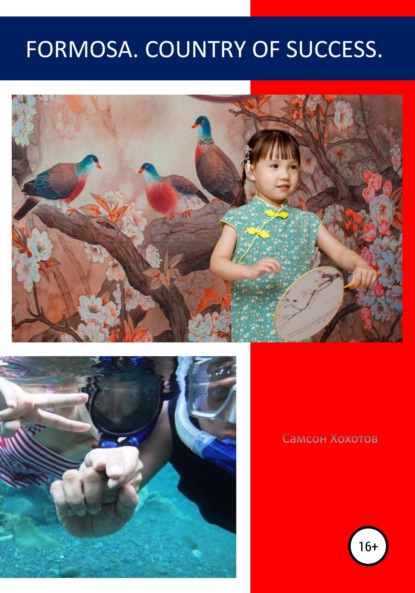По всем вопросам обращайтесь на: info@litportal.ru
(©) 2003-2024.
✖
Formosa. Country of success
Настройки чтения
Размер шрифта
Высота строк
Поля
Hill tribes include (from north to
South):
Saysiyat
Atayal
Truku (Taroko or Sedek)
Thao
Tzou
Kanakhabu
Saaroa
Bunun
Rukai
Ami (Pantsakh)
Puyuma
Paiwan
Officially, Yami (Taoist) is also referred to as Gaoshan. Yami live on a small island of Lanyu South-East of Taiwan. They speak the Austronesian language Yami, which resembles the Filipino language, Tagalog.
History of settlement
The history of Taiwan, with the appearance of the first humans, goes back as far as the
Upper Paleolithic period.
In the Taiwan Strait, near the Pescadores Islands (the Penghu Islands), fishermen fished out the jaw of an ancient man who belonged to the species Homo erectus. The first humans appeared in Taiwan around 50,000 BC. Some scientists claim the Negro-Australoids to be the first settlers in Taiwan since the Paleolithic, regarding archaeological and
has disappeared over time. Almost simultaneously with the Negroids, the Indonesians settled in Taiwan. The
Austronesians are believed to have reached Taiwan, the Korean Peninsula, Northeast China and Japan by sea.
Scientists generally believe that Java and Sulawesi provided the principal source of Austronesian migration. Additionally, Oceania is another source of migration, as evidenced by the megaliths at the eastern coast of Taiwan and anthropological observations.
The resettlement was not simultaneous but occurred in waves throughout the Neolithic period, as evidenced by the Corded Ware finds. Recently, researchers have concluded that both processes took place in Taiwan migration and autochthonous development. The migrants had adapted to the new conditions, and their descendants became aborigines.
The earliest archaeological culture in Taiwan was the Changbin culture, named after the place of finds in the east of Taiwan. Sites of ancient Taiwanese have also been located in other locations in Taiwan, especially in Tainan County and in
the Taipei Basin. Most likely, they were representatives of the Australoid race and inhabited all of Southeast Asia between 10 and 45 thousand years ago.
It is Taiwan that is the ancestral home of the Austronesian languages. In around 8000 years B.C. and as evidenced by archaeological finds, Austronesian native-speakers initially migrated from the east coast of China to Taiwan.
Native speakers of these languages only later, according to the data of historical linguistics, began to migrate from the island of Taiwan by sea throughout Oceania. This migration is understood to have started about 6,000 years ago and occurred in several stages. Taiwan's Neolithic past is the Dabenken culture (2700-5000 BC).
The first Taiwanese crops were yams and taro. From the 2nd millennium B.C., the natives of Taiwan began to breed dogs and pigs. The oldest evidence of life in Taiwan is the skeleton of a young woman with a child in her arms found near the city of Taichung. Following scientific analysis, the age of the fossils is around 4800 years, and therefore they belong to the Neolithic era. The earliest mention of the island of Taiwan was in Chinese sources of the 3rd century BC. This information is, however, very scarce. The Chinese, being close neighbours, were in no hurry to colonize the island.
By the third century, when life on the island was relatively- well established, military expeditions by the Chinese began. Crafts had developed, and agricultural plants grew. The early Iron Age on the island, represented by the Jingpu culture, dates back to the 1st millennium BC.
Over time, the local ceramic pottery tradition disappeared. Local craftsmen learned how to make products from porcelain and metal. The Taiwanese achieved sophistication in the production of copper bells that scare away evil spirits.
And in the 1st millennium AD, iron knives and spearheads are already appearing. These items belong to the Nyaosun culture.
Production of plain red-brown ceramics (without ornaments) begins.
The development of navigation, characteristic of the rest of the Austronesians, fades into the background, while the development of the island is becoming the main priority in the life of the Taiwanese. Despite the difficulties, little by little the Taiwanese natives selflessly mastered even the remote mountainous regions.
The ancient Chinese chronicles Hou Han Shu and San Go Zhi contain the first mentions of an island called Yizhou (the island of the barbarians).
Since the Sui period (years 581 through 618), Taiwan is more often called Lucyu (after the name of a small kingdom in the southwestern part of the island).
The island has been found under its modern name in written sources since 1599. Trade and navigation across the Taiwan Strait between mainland China and the island began long before the Chinese explored it.
The first Chinese military expedition to Taiwan was noticed in the year 230.
In 610, the 10,000-strong Chinese army made a new campaign against Taiwan and Penghuledao, after which links between China and these islands became more regular. Taiwan was officially incorporated into China (as part of the Fujian province) during the twelfth century. During the twelfth to fourteenth centuries, the Chinese tried to gain a foothold in Taiwan, partially mixing with the local population.
In 1360, due to the increasing military importance of the island, the Office of Oversight was founded on it, which was the first Chinese local governing body in Taiwan. During this period, the flow of immigration to the island from the provinces of Fujian and Guangdong increased. The process of the development by the Chinese accelerated, and agriculture and crafts developed. The indigenous tribes were then subsequently forced into the mountainous areas, and the Chinese settlers began to develop fertile coastal lands and coastal-water fishing.
Since the 16th century, the island has become attractive to many. First came the Japanese feudal lords and pirates, who made vain attempts to gain a foothold in Jilong, Kaohsiung, Hualien. These were all successfully repelled. In 1550, a Portuguese ship was sailing not far from Taiwan. The enchanted Portuguese seafarers immediately gave the island
a name, Formosa (Beautiful). In 1550, a Portuguese
ship was sailing not far from Taiwan. The enchanted Portuguese seafarers immediately gave the island a name – Formosa (Beautiful).
There is an assumption that the first European who saw the island was Dutchman Jan Huygen van Linschoten (1563 – 8 February 1611).
In 1592 being a navigator (and passing by an island with lush greenery and mountain peaks on a Portuguese sailing ship), he marked it in the logbook as "Formosa".
"Taiwan" has been in use since the early 17th century. In the early 17th century, the Dutch brought buffaloes to Taiwan. Thanks to this, the natives began to use draught cattle.
In 1622 the island came under the control of the Dutch from the East India Company. From 1626, Taiwan started to arouse burning interest in Spain, which intended to send its warships to the shores of the "wonderful" island. Moreover, Spain has managed to gain a foothold in northern Taiwan.
In 1626 Spain sent a fleet of warships from Manila to northern Taiwan and established a small colony named "Spanish Formosa". Fort San Salvador was established to counterbalance Dutch rule in southern Taiwan and protect Spain's interests in the shipping route between China's Fujian province and Manila in the Philippines.
However, in 1642, after several years of battles, the fort was handed over to the Dutch.
The unfolding struggle between Spain and Holland for the possession of the island ended in 1642 to satisfy the interests of the latter.
In September 1652, a major uprising of the local aboriginal population under the leadership of Guo Hua broke out against the Dutch colonialists. Inspired rebels tracked scattered groups of Dutchmen appearing in different parts of the island, fighting with them to the death.







